What does the Transition Smuggler Alloy NX and NASCAR have in common? We’ll tell you how Transition’s most affordable model follows an old tradition of American history, and why it’s perfect for smuggling moonshine.

NASCAR: huge rear-wheel drive engines built into seemingly normal sedans competing in the world’s most dangerous race. The drivers are celebrated as national heroes in the USA. But the origin of NASCAR is anything but heroic and that’s exactly where you’ll start to see the parallels to the Transition Smuggler. The most obvious being the name, as today’s stock car racing scene has its roots in the 1930s, when, thanks to prohibition, the smuggling of moonshine provided the sustenance of many Americans. On the surface, vehicles used for this were indistinguishable from production vehicles, you would have had to look beneath the hood to see the 500 hp engine. These big, powerful engines were used to get away from the police in a car chase. Like the smuggler vehicles of that time, from the outside the Transition Smuggler sports an inconspicuous blue-grey paint job with curved tubes reminiscent of a 1940 Ford Coupé. But hidden beneath the hood is the new Speed Balanced Geometry.

Like the smuggler vehicles of the 1930’s, the Transition Smuggler doesn’t reveal what’s hidden beneath the hood.
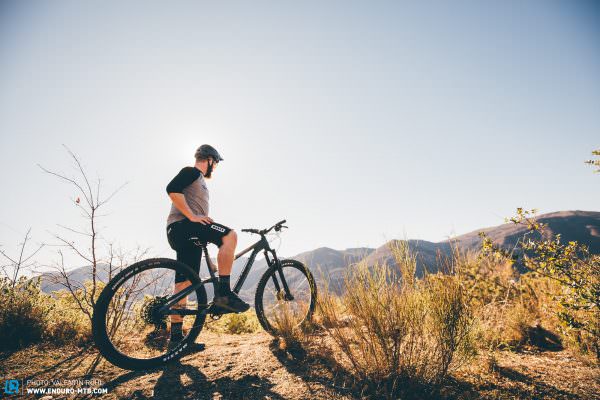

At second glance, however, you will notice some well thought-out details, for example, the durable Enduro Max Bearings in the pivots, protectors on the down tube and on the chainstay as well as the internally routed cables, which are clamped so that they don’t make a sound. Only the cables for the rear brake are routed along the outside of the frame, which should make maintenance and assembly work much easier. Also, there is space in the front triangle for a large water bottle. Whether you use it for water or home-made liquor is up to you.
Spec of the Transition Smuggler
The Smuggler NX is simple, solid and fully functional. However, we would have expected a little more for the € 3,399 price tag. The many entry-level components add up to an heavy total weight of 15.19 kg. Here are the most important features: The suspension on the Transition Smuggler NX Alloy is taken care of by a RockShox Revelation RC suspension fork with 140 mm of travel and a RockShox Deluxe RT shock with 120 mm of travel. Also from SRAM are the Level T brakes and the 1×11 NX drivetrain, which do the job they’re meant to, but for the brakes, we would have preferred something more powerful. The 40mm stem and 780mm handlebars from Race Face are spot on. The universally coveted MAXXIS Minion DHF/DHR II tyres in the 3C Maxx Terra version with EXO casing also come as standard on the entry level Smuggler.
Fork RockShox Revelation RC 140 mm
Rear shock RockShox Deluxe RT 120 mm
Drivetrain SRAM NX 1×11
Brakes SRAM Level LT
Stem Race Face Aeffect R 40 mm
Handlebar Race Face Chester 780 mm
Seatpost RockShox Reverb Stealth
Hubs/Rims Novatec/WTB STPi29
Tires MAXXIS Minion DHF/DHR II
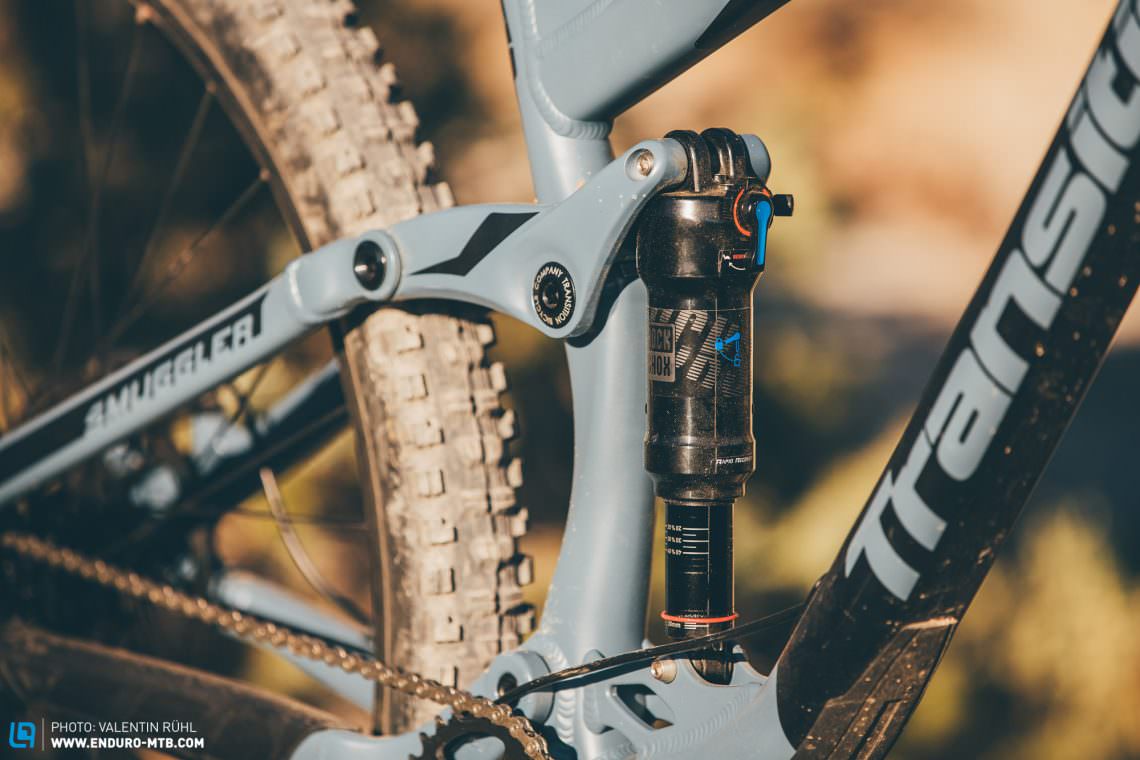
The Smuggler’s design is quite something!
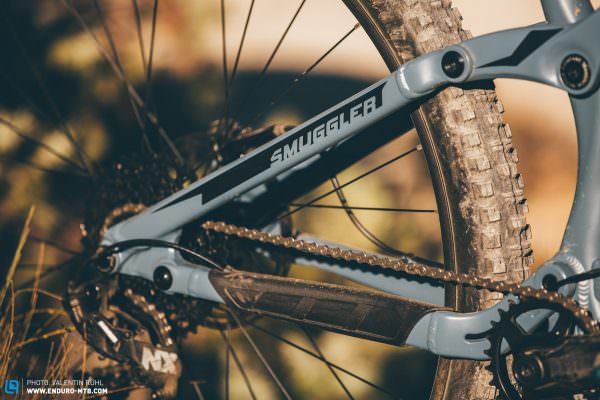
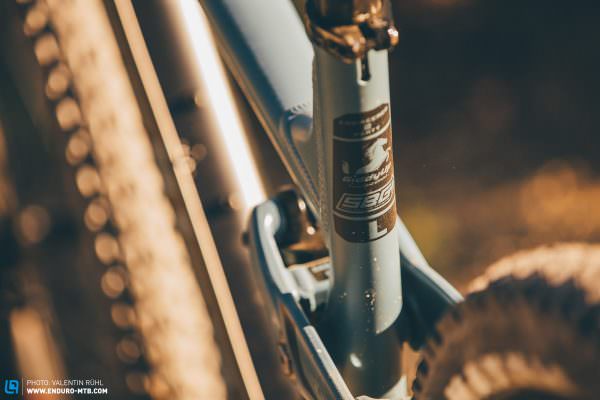

For € 3,399, we would have wanted a much better brake!
Geo of the Transition Smuggler
Particularly interesting regarding the geometry of the Smuggler is the concept of Speed Balanced Geometry, which Transition revealed last year. According to Transition, the purpose of this concept is to get their bikes to feel more composed at speed without the negative effects of a slack head angle. The head angle of 66° in combination with a long reach of 475 mm in size L provides stability, but to prevent the front wheel from becoming too susceptible to impacts and ruts, Transition deliberately uses suspension forks with less offset. The increased trail (the difference between the virtual steering axis and where the tire actually contacts the ground) keeps the front wheel more stable and under control, especially at high speeds. To remain agile and responsive, however, the Smuggler comes with 430 mm short chainstays.
| Size | S | M | L | XL |
|---|---|---|---|---|
| Seat tube | 400 mm | 410 mm | 450 mm | 495 mm |
| Top tube | 571 mm | 596 mm | 625 mm | 653 mm |
| Head tube | 100 mm | 100 mm | 110 mm | 120 mm |
| Head angle | 66° | 66° | 66° | 66° |
| Seat angle | 77.0° | 76.3° | 75.8° | 75.3° |
| Chainstay | 430 mm | 430 mm | 430 mm | 430 mm |
| BB Drop | 35 mm | 35 mm | 35 mm | 35 mm |
| Wheelbase | 1,159 mm | 1,184 mm | 1,213 mm | 1,242 mm |
| Reach | 425 mm | 450 mm | 475 mm | 500 mm |
| Stack | 615 mm | 615 mm | 624 mm | 633 mm |
Small jumps, bumps and roots are no problem for the Smuggler.

The Transition Smuggler climbs up steep and winding trails with ease and comfort. The reason for this is the steep seat tube angle of 75.8°, which positions the rider centrally and upright on the bike. The decreased fork offset means that despite the slack head angle and short stem, the front wheel doesn’t feel floppy. During sprints and short bursts, we felt the Smuggler’s 15.19 kg weight, making it a bit sluggish. Although you will get up the mountain, you shouldn’t be in a hurry when doing so. The weight will also rob you of power on longer outings. If you intend to do a lot of climbing on your Smuggler, you should consider upgrading to a 12 speed SRAM GX Eagle drivetrain.

It’s on the downhills that the Transition Smuggler shines, showing what a trail bike with 140 mm of travel at the front and 120 mm at the rear is capable of. Small jumps, bumps and roots are no problem for the Smuggler. On rough trails, the 29″ wheels also play an important role, as they don’t tend to dip into every hole, rolling more smoothly over roots and irregularities. But as soon as things really get wild, even good geometry cannot hide the lack of travel. We wouldn’t feel comfortable riding the Smuggler through large rock gardens, off big drops or down downhill race tracks. Beyond that, we had to rest our arms once or twice on longer descents and would have been happy about better damping performance on the fork. Through curves, however, the suspension delivers sufficient feedback for fast switchbacks – provided the Revelation’s compression lever is closed by a quarter turn. The amount of grip offered by the MAXXIS Minion DHF/DHR II will instil any rider with a lot of confidence, even on unknown trails.

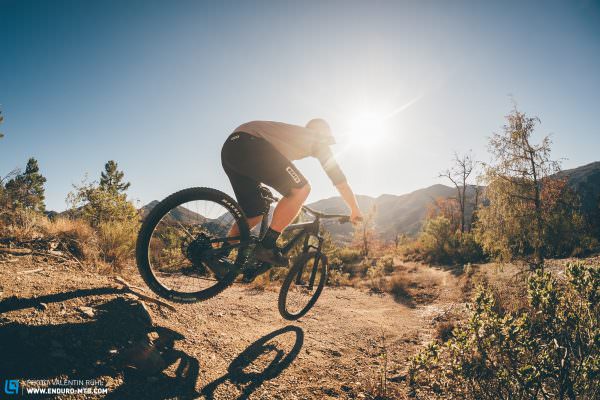
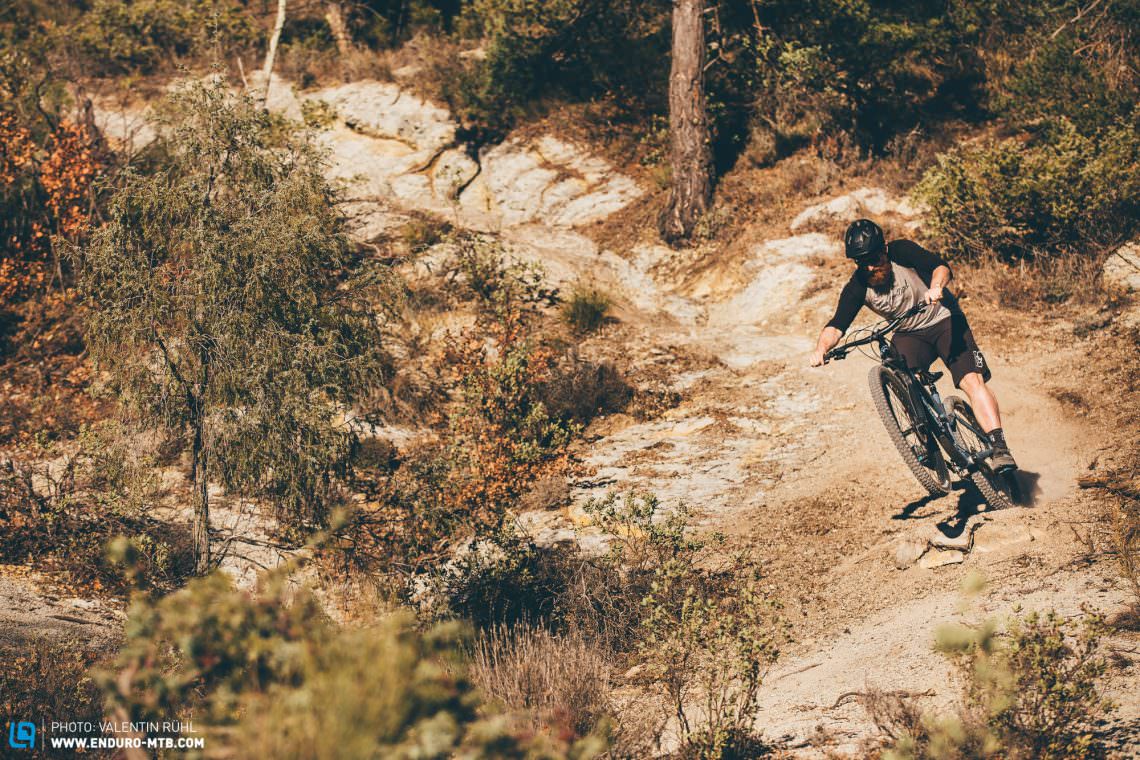
The rider’s position is pleasantly central in every riding situation, so you never have the feeling of riding with too much weight on the front or rear wheel. The short chainstays give the Transition a playful character, good for technical or tightly winding trails. As soon as things get steep and fast, the slack head angle (66°), the long reach (475 mm in L) and the short fork offset show their strengths, as the Smuggler holds its lines with confidence. Plan enough braking distance, however, because the SRAM Level T does not offer enough power to drop the anchor at the last moment.
Conclusion
The Transition Smuggler’s reliable and comfortable climbing abilities paired with its potent downhill geometry makes it ideal for smuggling moonshine at night. The possibility of mounting a large bottle is an advantage too. If you are looking for a down-to-earth trail bike that convinces with great geometry and a potent rear linkage, this is it. At € 3,399 the bike is not a bargain given the spec.
Uphill | Downhill | Stability | Agility
Value
Strenghts
– Geometry
– Tyres
– Look
Weaknesses
– Value for money
– Brakes
For more information head to transitionbikes.com
Did you enjoy this article? If so, we would be stoked if you decide to support us with a monthly contribution. By becoming a supporter of ENDURO, you will help secure a sustainable future for high-quality mountain bike journalism. Click here to learn more.
Words & Photos:









